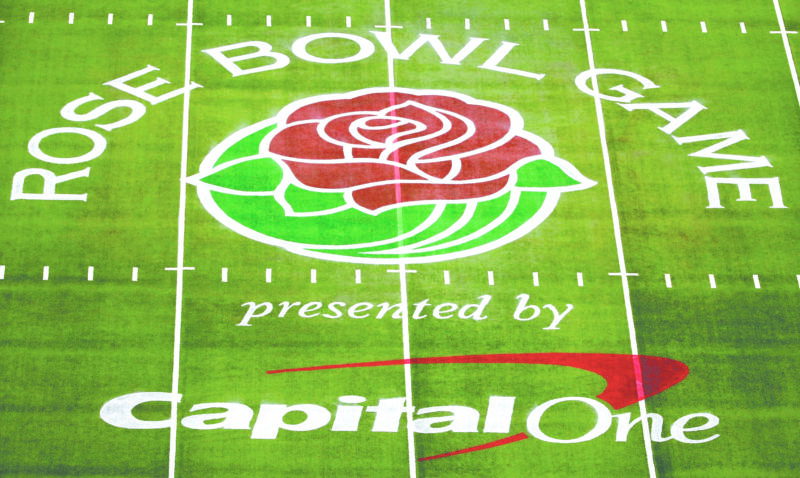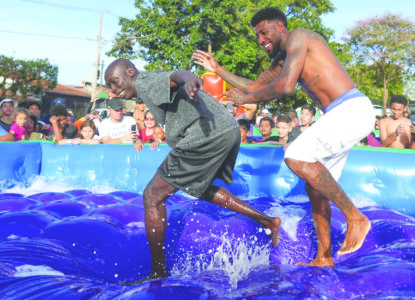Schools use field logos, concession price hikes to pay for new era of sports

The Rose Bowl Game logo is displayed along with a brand sponsor on the field at AT&T Stadium before the Rose Bowl between Notre Dame and Alabama in Arlington, Texas, on Jan. 1, 2021. (AP file photo)
It was an exercise in corporate branding that wouldn’t have raised an eyebrow in most pro sports. In college sports, it bordered on revolutionary.
In a full room of reporters, boosters and executives, the University of South Carolina delivered the news that it was bringing on a new sponsor that would put its logo on the football field for Gamecocks home games, starting Sept. 6 against South Carolina State.
The deal with a machinery company was the centerpiece of a partnership that, Gamecocks athletic director Jeremiah Donati explained, represented the “largest single financial investment into our athletics department in our history, which will help us shape the future of our programs and our university for years to come.”
In a nod to the new realities of college sports, the NCAA just 14 months ago lifted a decades-old restriction on branding on the field of play.
It opened a new financing stream for universities that are sharing up to $20.5 million in revenue with their players over the next year while also doling out millions more in scholarships in an industry reshaped by the multibillion-dollar lawsuit settlement that has turned college sports into something that looks more like the pros.
Not everyone is seeing money walk through the door.
Just last week, the board Virginia Tech received a bracing message from athletic director Whit Babcock: Without an influx of around $44 million to bring the sports budget to $200 million, the Hokies would keep falling behind.
“If we don’t radically leap forward now,” Babcock said, “we’re likely sealing our own fate for years and generations to come.”
Field branding is part of a bigger set of tools that schools are using to try to stay competitive; often those tools involve asking students, fans and the public to pay more.
“As the financial requirements in college athletics continue to evolve and grow, the pressure on athletic departments, our multimedia partners and others to provide new and different revenue streams is certainly there,” said J Batt, the athletic director at Michigan State, which has partnered with PlayFly Sports to identify new ways to raise money.
Ticket and concession prices
These have been couched in lots of different ways, but bottom line, it’s going to cost more to attend games at many schools.
Tennessee was among the first to introduce what it called a “talent fee,” which was a 10% surcharge on all athletic tickets.
Multiple Big Ten teams have increased student season ticket prices for football. Arkansas added a 3% “Student-Athlete Scholarship Enhancement Fee” to concessions sold at its sports events in what athletic director Hunter Yurachek told fans in a letter was a “small but meaningful way” to support athletes.
Nebraska, for the first time, will be selling beer to fans in general seating.
Adding to cost of tuition
Among the schools that added “athletic fees” to the cost of attendance are Clemson ($300 a year), South Carolina ($300), Louisville ($200) and West Virginia ($250). At Clemson, that fee is expected to raise around $7 million a year.
One possible hiccup: A bill making its way through Congress proposes to bar schools from using these sort of fees to bankroll college athletic programs.
Asking boosters for more
Aside from tying increased giving to ticket prices, athletic directors are being transparent with their fans and simply letting them know that things are going to cost more.
In a letter to the Michigan fan base from June, athletic director Warde Manuel said payments to players and an increase in scholarship budget had the department facing a $27 million deficit for the 2025-26 school year.
He gave a detailed analysis of measures Michigan has taken to cut the deficit to $15 million. It included staff reductions and a $6 million reduction in TV revenues the department gave back to the university. But the letter came with the overarching message: “We still need your continued support.”
___
This story corrects that South Carolina’s opening home game is Sept. 6, not next Sunday.
___
Get poll alerts and updates on the AP Top 25 throughout the season. Sign up here. AP college football: https://apnews.com/hub/ap-top-25-college-football-poll and https://apnews.com/hub/college-football




